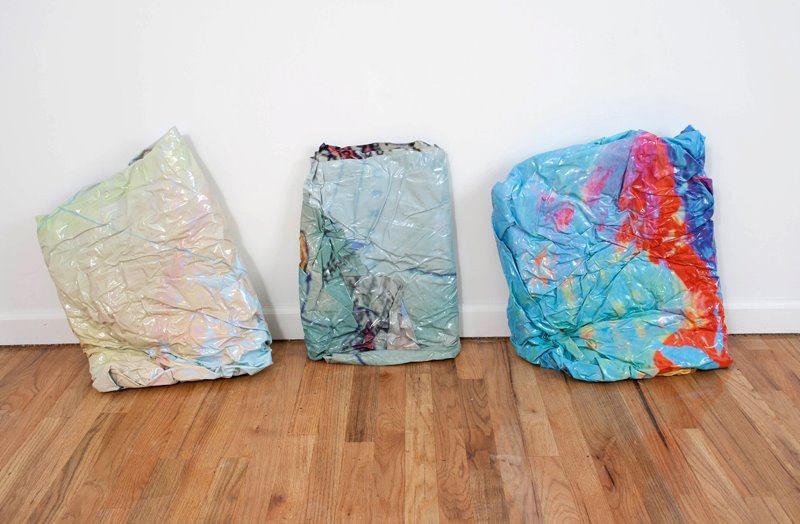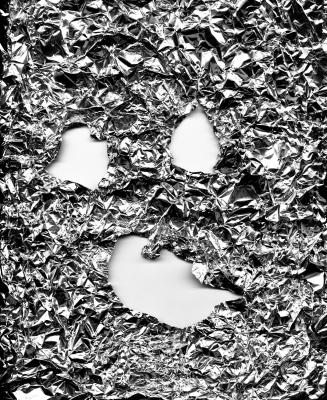You Can Never Go Home Anymore: The Conundrum of Pre-Apocalyptic Art
by R.H. Lossin
The rain is coming down in sheets as a small group of sweaty people emerge from the windowless back room of a bar on East Houston. It is the after party for You Can Never Go Home Anymore, the inaugural exhibition of Louis B. James gallery and as we stand under an awning watching unavailable yellow cabs splash through a filthy pond-sized puddle, the show’s title becomes comically literal. But even if this enviro-semantic coincidence is entertaining, the rain, on the heels of a hurricane, is not a joke. The earth’s environment is irreversibly damaged due to anthropogenic climate change and other side effects of industrialization. No matter how many bright lights, loud noises, fog machines and drinks we surround ourselves with, this fact remains.
But before we collapse into apathy and despair, these are some other facts: the taxis are still driving through puddles, not being engulfed by them; the home I am trying to get to is still standing; we are at a party dancing; a new gallery has just opened. This is not what disaster looks like--we still have the time and the resources to make, look at, and write about art, to contemplate fluorescent, vinyl shapes displayed in white rooms.
And this is troubling. This luxury is perverse. In this context tragedy is intellectually stimulating. The work on display is good, but the weather makes it better. It gains a certain complexity in relation to crisis that it would not have in sunnier, happier times. In the current climactic context, the theme that emerges from You Can Never Go Home Anymore is social and ecological collapse and as the title implies we have passed a point of no return. But unfortunately, home is where you live whether you can go back to it or not and these artworks--socially conscious art in general for that matter--cannot escape this impossible contradiction. Art under capitalism will always be at odds with itself and artists are never quite at home in the first place.
Conceptually anchored by the consumerism, waste and attendant dishonesty that is ultimately fueling runaway climate change and wildly inequitable resource distribution, all of the work on view is produced from the very materials that produce the problems it critiques. From Virginia Poundstone’s delicate mobile constructed of carefully balanced currency entitled Global Commodity Chain Theory, to Kelly Jazvac’s slumping candy-colored sculptures made from salvaged adhesive vinyl, the work is unabashedly critical of that which made it materially possible.
Immanent critique is hardly a new and interesting critical mode and runs a serious risk of slipping into cynical knowing. As the writer Lawrence Durrell once pointed out, “a culture dies when it becomes conscious of itself” and, considering the popular uses and abuses of irony over the last decade or so, I have to agree with him. But in-betweeness might be offered as a structural, or formal corollary to the works’ ideological content. For there is something desperate about this work, a sense that other options would be welcome but simply are not there. We are not choosing to laugh at ourselves, we are stuck. And more than indicating a slight critical shift, being stuck in between might offer far more food for thought than the more obvious social critiques offered by works made from advertiser’s left-overs and fashion world rejects. This is not to minimize the value of these statements--consumerism, class, race, environmental disaster, in short reality, are things that artists should be addressing--but it is this awkward position of neither here nor there but both at once that art, in all of its glorious ambiguity, is uniquely qualified to address. This ambivalence and discomfort, the being part of something that is reprehensible, is not necessarily something that can be reconciled and it is therefore not something that can be adequately dealt with by scientists or environmental journalists or other people far more equipped to explain why it is raining like this. It is a cliche but its worth pointing out again--artists trade in the human condition and our current condition, as well-heeled urbanites, is impossible contradiction. Cognitive dissonance isn’t just a part of this life, it is its organizing principle.
The internal contradictions of a consumer culture are tidily summarized by Poundstone’s series of sculptures constructed from cargo flower boxes and steel: Exquisite Roses (2011), The Legend of the Valley of Flowers (2011), and Rosadex (2011). The proliferation of cut flowers on the streets of New York City, their significance as symbols of romantic love, expressions of condolence, and use in celebration make them one of the best illustrations of how fucked up we are. To display their re-formed shipping containers is not only to acknowledge the distance they have traveled and by extension their carbon footprint, in their deconstruction and reconstruction is also suggested a symbolic and semantic critique--a disassembling and examination of the language of flowers--an age old codification of emotions that points to the underlying archaism of our culture as well as the vast amount of information that is repressed in the service of uncomplicated communication. Simple, uncritical sentiments are as much a part of the problem as the material conditions under which the flowers are grown and distributed. A lack of thought, on both the level of the personal gesture and political views, is the intellectual condition that creates the demand for this inordinately wasteful industry of flying flowers thousands of miles for them to die on a table. But then, we all like pretty things, and the containers transformation into an art object suggests the possibility of other, more ethical forms of looking and visual pleasure.
Arnold J. Kemp’s series Don’t Make Friends, 43x35 inch archival pigment prints of masks made from tinfoil offer the opportunity for several readings. In photographing the masks and printing them at such a large scale, Kemp turns household trash (the eye and mouth holes torn in the the foil would, under normal circumstances just render it useless) into Art in the crassest way possible. This is not to say that the pieces fail--quite the opposite. Large framed photographs signify Art in the most obvious way and the black frames are a very noticeable component of the work. But the images also speak to racial luxury, by signaling the African masks co-opted by modernist painters. On the one hand there is a nod at the art world’s ability to manufacture value through framing, but also the value bestowed/created in the appropriation of African artifacts by white men.
The mechanisms of value creation are the literal material of Kelly Jazvac’s sculptures. Constructed from adhesive vinyl scraps left over from storefront signage that Jazvac personally wheedles out of advertising companies, the abstract fluorescent sculptures have a deflated quality that contrasts sharply with their lively palette. The bright colors catch the eye and thus repeat the material’s original function, but the sign no longer signifies.
Blue (2011) and Blonde (2011), wall-mounted constructions of commercial vinyl, suggest much like Poundstone’s work, a semantic re-purposing as much as a material one. Used for storefront signage, commercial adhesive vinyl is not a consumer product in itself but much like the boxes used to ship flowers, it is a necessary preliminary to a commercial transaction -- think “sale.” Jazvac’s sculptures are therefore a sort of negative, the material left out of, but nonetheless necessary for the production of these signs. Their reformulation, according to a different visual code (she sorts the material according to color) suggests the wealth of meaning below, behind and around the literal signs of consumerism--a sort of return of the repressed.
What then is being repressed in the service of a sale? What is being actively ignored in this invitation to consume? The obvious answer offered by these sculptures is a large amount of non-biodegradable by-product. But in their form--slightly thicker than the flat signage they came from, jutting off the wall and in many respects resembling spilled paint or some leak or other accident--they also speak to psychological and social excess.
It is worth noting that the agencies from which Jazvac salvages her material are often reluctant to give her what they would normally throw out, forcing her to cultivate careful relationships and build an almost therapeutic trust before they will turn over their trash.
More hopefully, this resurrected trash reminds us that there is a value in this digging, this acknowledgement of things that we are in the habit of ignoring, of literally burying; that looking elsewhere has the potential to produce beautiful objects whose function is not repressive but cathartic. Objects that provide small moments of gloriously non-contingent, unwasteful pleasure.
Jean-Paul Sartre once wrote, rather ridiculously, that “when you are up to your neck in shit the only thing you can do is laugh.” Or you could kick a hole in the side of a Wal Mart. “They are made of styrofoam,” Jazvac informs me, “all you need is a good pair of steel-toed boots.”
R.H. Lossin



